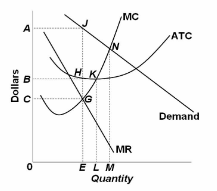Refer to the diagram. At the profit-maximizing level of output, the firm will realize:

A. an economic profit of ABHJ.
B. an economic profit of ACGJ.
C. a loss of GH per unit.
D. a loss of JH per unit.
A. an economic profit of ABHJ.
You might also like to view...
Bringing oil to the market is a relatively long and costly process. The whole process from exploration to pumping significant amounts of oil can take years. What does this indicate about the price elasticity of supply for oil?
A) The elasticity coefficient is likely to be very high and supply is inelastic. B) The elasticity coefficient is likely to be low and supply is highly inelastic. C) The elasticity coefficient is likely to be low and supply is highly elastic. D) The elasticity coefficient is likely to be close to zero and supply is perfectly elastic.
The "crowding out" effect refers to the:
A. increase in domestic investment by foreigners, leaving little investment choice for domestic investors. B. reduction in the interest rate caused by governments running a deficit. C. reduction in domestic investment caused by governments running a deficit. D. irrational exuberance of the market reducing the number of rational investments available.
Let's be careful about defining our terms properly. Aggregate supply is the total value of
a. goods produced in the manufacturing sector that they are willing and able to supply at varying price levels b. goods and services that firms in the economy are willing and able to supply at varying price levels c. services that suppliers are willing and able to supply at varying price levels d. goods and services less the amount exported that firms are willing and able to supply at varying price levels e. goods and services including imports that firms are willing and able to supply at varying price levels
A sizable appreciation of the U.S. dollar in the mid-1980s
a. raised U.S. exports and imports. b. raised U.S. exports and reduced imports. c. reduced U.S. exports and imports. d. reduced U.S. exports and raised imports.